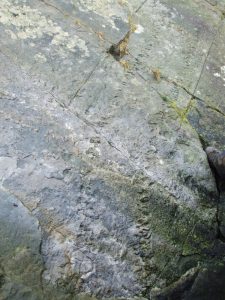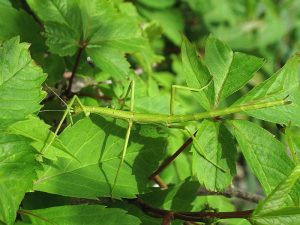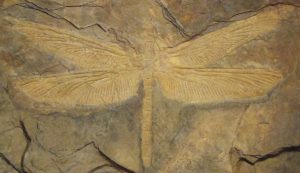When doing school sessions with the BDP, we always give an opportunity for the kids to ask us any of the burning questions they have about dinosaurs. In a recent session, in this moment, a keen child raised their hand and asked, “What is the longest ever insect?”
This is, of course, a demonstration of a child thoroughly misunderstanding the assignment, but that doesn’t stop it from being a legitimately intriguing question. What is the longest ever insect?
Hearing a question like this, any palaeo-keen child will jump to the opportunity to show off their knowledge of the prehistoric monster Arthropleura. It’s a beasty that, even if you’ve never heard the name, you may well have seen in some prehistoric media. It’s one of the non-dinosaur clichés of the science in mainstream culture; along with Dimetrodon, Megalodon, and the Woolly Mammoth.

Much like all those creatures mentioned above, Arthropleura is not a dinosaur and did not live with the dinosaurs, despite how often it may well be depicted alongside them. It actually lived a full 100 million years before the first dinosaurs, in the global rainforests of the Carboniferous period (330Ma). Arthropleura was a giant millipede, first identified from fossilised trackways that would scare the life out of any myriopodophobe.

These rows of parallel footprints are 55cm apart, giving an estimated length of the animal of 2.5 meters. A truly enormous size that was later confirmed by the discovery of body fossils of this incredible creature.

Arthropleura is certainly an impressive organism, but let’s get out of the way the thing a certain number of you have been muttering with disapproval since I first brought it up. Arthropleura is not an insect. It’s almost certainly the animal the kid was dreaming of and would be a very easy and satisfying answer, but science is all about being pedantic, and the fact is that it isn’t an insect.
If Arthropleura isn’t an insect, then what is? Insects as a group share several traits, though one of the most commonly cited is having six, jointed, exoskeletal legs. This rules out the centipedes and millipedes, as even though they are colloquially often called insects, if there’s one thing they are known for, it’s having a boat-load of legs. So with this new leg-limiting factor in our search, what are we left with?
First of all, let’s check the insects we have today. Though this is a task you’d imagine to be relatively straightforward, it is actually hugely complicated. Insects are an incredibly diverse group, and we aren’t even close to finding out the true range of their diversity. New species are constantly being discovered, so to say for certain that what we know of now is all there is out there would be a very naïve thing to say.
Starting close to home, the longest insect we have here in the UK isn’t even meant to be here. Acanthoxyla inermis is a stick insect native to New Zealand that found its way to Britain accidentally at some point during the 20th century. This kind of inadvertent wildlife trading happens with a worrying frequency in the age of global trade, and often with disastrous consequences, the invaders wreaking havoc on the local biodiversity.

Thankfully in the case of these stick insects, the impacts have been minimal. Acanthoxyla don’t go out of their way to steal the food resources away from others, they aren’t aggressive or poisonous, and the local birds seem to find them tasty enough to keep them pretty well mixed into the countryside menu. As such they’ve developed a healthy breeding population here and thus our starting close to home comfortably features an animal from literally the opposite side of the planet.
But before you worry about these stretched out kiwis being dangerous to us, their common name is the ‘Unarmed Stick Insect’, so you needn’t be scared of them. It would be hard for an animal as thin as a stick insect to conceal any kind of weapon anyway. However, in some Maori cultures, having one of these insects land on you is a sign that you are pregnant, so it could be giving you a different type of surprise.
Measuring up to 10cm in length, these stick insects are about 2.5cm longer than even our largest endemic species, the Emperor Dragonfly. But our best efforts here are dwarfed by those of the insect’s true paradise, the tropics.
The current record holder for longest insect on earth is Phryganistria chinensis, otherwise known as the ‘Giant Chinese Stick Insect’; a name which really does all the leg work in telling you the headline facts about the kind of animal it is.

This titan measures up to an astonishing 62.4cm in length. This is a stick insect that you wouldn’t hold in your hand so much as it would take your arm.
But this child hadn’t asked me simply what the longest living insect was, he had specifically said longest ever, leaving me with no choice but to search the entire fossil record for anything that can tick every insect requirement box and still measure more than our Phryganistria.
Though there are a few individual examples of relatively colossal sizes in bugs across prehistory, for the majority of their time on earth, insects have been more or less comparable in size to those we find today. Even during the Mesozoic (the age of the dinosaurs), I can’t find evidence of any insect longer than Cretophasmomima melanogramma, which was a stick insect clocking in at about 56cm. The only time insects consistently seemed to reach freakishly large scales is back in the time of Arthropleura, the Carboniferous.

Arthropleura wasn’t the only giant arthropod of the time; the true insects were right alongside them. And, like the majority of insects today, many of them had wings. In the skies above our giant millipede the air was buzzing with the sound of giant dragonflies.
The Meganeurans were top predators of the time, with wingspans similar to those of modern Peregrine Falcons. The genus Meganeuropsis clocks in at 71cm from wingtip to wingtip.
So there it is right? 71 is a bigger number than 62, so we’ve found an insect longer than Phryganistria. Well, not exactly. Dragonflies hold their wings out perpendicular to the body, not along their backs like Damselflies. So that figure of 71cm was really more a measure of how wide it was. And if we were looking for the widest insect, job done, we’ve found it. But we aren’t. This kid specifically said longest, and we are being pedantic. And when all is said and done, the wingspan might have been 71cm, but the actual body length of Meganeuropsis was only 43cm. That’s around 20cm short of our benchmark.

And that leads us at last to the end of my search, not with the fanfare of having found an answer, but with a shrug of an open ended question. I don’t know what the longest insect was, and it’s a trickier task to search than I gave it credit for. As is so often the case, a child’s question has stumped me.
It may well be that the longest insect of all time is alive today in Phryganistria, which would be quite an impressive claim to fame for our particular era. It may be that the true answer is a fossil languishing unidentified gathering dust in a museum store room, or still hidden in the rock waiting to be discovered. Or (and much more likely) completely erased from Earth’s memory due to never preserved at all. Or of course it could be hiding under your bed, waiting to crawl onto your face as you sleep.
It’s not the most satisfying ending to this line of enquiry I’ll admit. But it’s often the case with science that you don’t get a definitive answer. So I ask, if you are reading this and can help in any way unravel this mystery, my inbox is open and hopefully we can get back to that child before they’re old enough that their own kids can pose them the same impossible question.
Rhys Charles is the Engagement Officer for the Earth Sciences department of the University of Bristol, and has headed the Bristol Dinosaur Project since 2016. (@tweetodontosaur)

